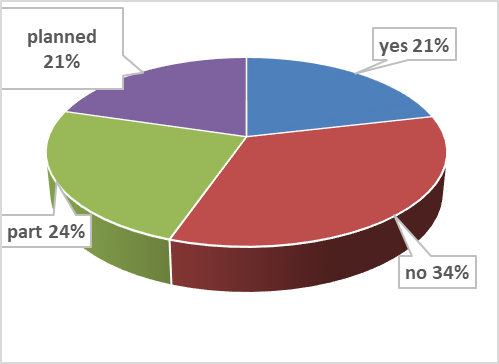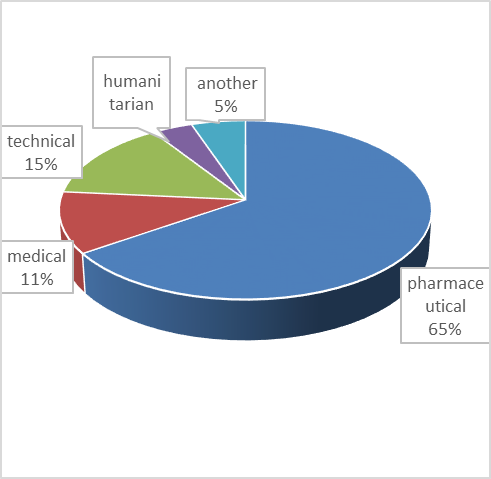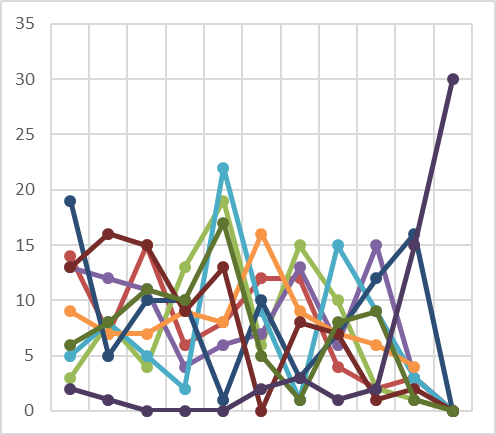Archive \ Volume.11 2020 Issue 2
The Analysis of the Indicators Affecting the Medical Stocks Management in the Armed Forces of Ukraine
Dmitry Drozdov, Olexander Shmatenko, Maria Bilous, Oleksandr Galan, Alina Koval*
Ukrainian Military Medical Academy, Kyiv, Ukraine.
Abstract
Medical supply facilities are an important element in the functioning of the medical property inventory management system in the Armed Forces of Ukraine, as they are designed to maintain medical supplies established by nomenclature and volume and provide them with health care facilities, operational commands, brigades, military units and peacekeeping contingents. The optimality of the management of the entire logistics system of medical supply to the Armed Forces of Ukraine depends on the efficiency of warehousing management.
Keywords: Armed Forces of Ukraine, inventory management, medical supplies
INTRODUCTION
Effectively formed medical property management policy in the Armed Forces (AF) of Ukraine is characterized by the existence of a document management system of medical property inventory management process according to international ISO quality standards and GSP and GDP good practices, information systems for accounting, inventory control and analysis of medical property defects. . In addition, the inventory management system of medical property should be provided by specialists with higher and secondary pharmaceutical education.
From the point of view of the logistical approach, on the way of its movement from the primary source (civilian supplier of medical property) to the final consumer (serviceman) the material flow can accumulate in the form of stocks in any part of the logistics chain [1]. Therefore, there is an urgent need for specially equipped places for their storage, as well as the implementation of such integral logistical operations as accounting, storage, sorting, assembly, packaging, etc. [2]. Such places are medical supply facilities - medical warehouses of the Ministry of Defense (MO) of Ukraine. Currently, the basic principles, requirements and rules of organization of parts and facilities of medical supplies, including the order of their placement and equipment, responsibilities of officials, the organization of their work are set out in the "Guide to medical databases, medical property centers inviolable stock and medical warehouses of the Ministry of Defense of Ukraine ”(Entered into force by the order of the Director of the Department of Health dated 20.12.2006 № 122) [1].
Thus, medical supplies are an important element in the functioning of the medical property inventory management system in the Armed Forces (AF) of Ukraine, as they are designed to maintain the established nomenclature and volume of medical supplies and provide them assigned to the supply of health care facilities, operational commands , brigades, military units and peacekeeping contingents. The optimality of the entire logistics system of medical supply of the Armed Forces of Ukraine depends on the efficiency of warehousing management. The purpose of the work is to analyze the indicators that affect the management of stocks of medical property in the Armed Forces of Ukraine for further development of a methodology for optimizing the management of flow processes in the medical supply system.
MATERIALS AND METHODS OF RESEARCH.
The materials of the study were the results of an expert survey of military personnel
Armed Forces of Ukraine. During the work the methods of information search, systematization, comparison, generalization, expert survey, mathematical-statistical and graphic modeling were used.
RESEARCH RESULTS AND THEIR DISCUSSION.
In order to analyze the compliance of the above requirements with the actual availability, an expert survey method was conducted. The proposed questionnaire contained blocks of questions related by logical connections and transitions.
The experts were servicemen and medical workers of the Armed Forces of Ukraine, the characteristics of their information group and belonging to the components of the medical supply system of the Armed Forces of Ukraine are presented in Table 1.
|
Table 1: Information characteristics of experts |
|||
|
Name of the sign |
Information group |
Code groups |
|
|
Components of the medical supply system in the Armed Forces of Ukraine |
Medical service management body |
Medical Forces Command |
1 |
|
Medical supply facilities |
Central medical institutions of the Ministry of Defense of Ukraine |
2 |
|
|
Medical warehouses (MS) of the Ministry of Defense of Ukraine |
3 |
||
|
Centers for the formation and storage of medical equipment and property of inviolable stocks (CFTZ MTiM NZ) |
4 |
||
|
Medical supply units |
Departments (offices) of medical supply (MP) Military Medical Clinical Centers (VMCC) regions |
5 |
|
|
Pharmaceutical centers (pharmacies) of the VMCC regions |
6 |
||
|
Medical property storage department military hospitals (MH) |
7 |
||
|
VG pharmacies |
8 |
||
|
Medical supply groups (mobile) VMG |
9 |
||
|
Pharmacies of military units |
10 |
||
|
Departments (offices) of the MP brigade |
11 |
||
Thus, the largest percentage of experts is represented by group 3 - 38%, then group 4 - 16%, group 6 - 15%, 11 - 12%. Other groups have a percentage less than 10. The professional characteristics of experts in the level of education confirm their quality selection, as 96% of them have higher education. Also, the selection of experts took into account many factors: position, age, work experience in this field, education, some of them are analyzed above. Acquired practice is a very important quality of an expert, because experts are somehow interested in researching the problem being analyzed. This is monitored by us in the analysis of the selection of experts taking into account the positions held. Thus, the group of experts is provided with specialists who have higher and secondary pharmaceutical education, work experience and a high qualification category.
The consistency of the experts' conclusions was checked using the Gamma Correlations coefficient [3]. In order to estimate the relationship between two variables, a correlation coefficient is usually calculated. Nonparametric analogues are Spearman's rank correlation coefficients R, Kendall's mau statistic and Gamma's coefficient. If the data has many matching values, Gamma statistics are preferable.
When answering the question of creating a document management system for the management of medical property stocks in accordance with international quality standards ISO and the requirements of good practices GSP and GDP in their institution (subdivision) of medical supply, experts' opinions were distributed as follows: yes - 21%, no - 34%, partially - 24%, not created, but planned - 21% (Fig. 1).

Fig. 1: Diagram of distribution of answers of experts concerning formation of system of document circulation of process of management of stocks of medical property in the Armed Forces of Ukraine
The existence of a system of cost accounting, inventory control and analysis of the causes of defects in medical property is evidenced by the high discrepancy between the answers of experts: yes - 64%, no - 36%. When analyzing the main logistical tools for managing stocks of medical property in institutions (subdivisions) of medical supplies, experts preferred the indicators presented in Fig. 2.

Fig. 2: Diagram of distribution of experts' answers to the main tools of medical property inventory management in the Armed Forces of Ukraine
Of these: determining the level of need for stocks of medical equipment - 29%, coordination of supply conditions - 25% have the highest rates.
This issue is also characterized by differences in the answers of experts on other indicators. If the indicators: analysis of medical property movement - 17%, determination of the optimal level of medical property stocks - 15% gained a significant percentage, then important indicators of forecasting medical property flows - 7% and assessment of the role of medical property stocks - 6%. No attention is paid to the use in the analysis of inventory management matrix ABC - 1%, matrix XYZ - 0.
As already mentioned, the consistency of the experts' conclusions was checked using the Gamma Correlations coefficient. The data are shown in table 2.
In this case, the agreement criterion (Gamma factor) is perceived as a criterion of significance.
|
Table 2: Consistency of expert opinions on indicators (8-9.1) |
||||||
|
Gamma Correlations. Marked correlations are significant |
||||||
|
Characteristic |
8,0 |
8,1 |
8,2 |
8,3 |
9,0 |
9,1 |
|
Unit |
0,89 |
-0,49 |
-0,30 |
0,11 |
0,17 |
-0,16 |
|
Age |
0,95 |
-0,47 |
-0,42 |
0,22 |
0,10 |
-0,10 |
|
Education |
0,97 |
-0,86 |
-0,77 |
0,22 |
0,17 |
-0,15 |
|
Position |
0,91 |
-0,55 |
-0,31 |
0,32 |
0,11 |
-0,10 |
|
Experience |
0,61 |
-0,30 |
-0,37 |
0,18 |
0,01 |
-0,02 |
|
Specialty |
0,97 |
-0,84 |
-1,00 |
0,26 |
0,20 |
-0,17 |
|
Special experience |
0,96 |
-0,37 |
-0,49 |
0,14 |
0,16 |
-0,17 |
|
Group |
0,91 |
-0,61 |
-0,30 |
0,20 |
0,19 |
-0,18 |
According to the results of scientific research, the system of medical property inventory management should be provided by specialists with higher and secondary pharmaceutical education, work experience and high qualification. Therefore, when analyzing the existing system of staffing, experts noted the advantage of specialists with higher pharmaceutical education - 86% (pharmacists). Specialists with secondary pharmaceutical education - 11%, employees of the Armed Forces of Ukraine (accountants and others) - 3%.
The distribution of experts' answers on the benefits of specialization of specialists in the management of medical stocks is presented in Fig. 3.
Experts preferred pharmaceutical specialization - 65%, as the main in guaranteeing the quality and safety of medicinal products. In second place with a percentage - 15% technical specialization, which provides security, relocation and computer (automated) accounting. Medical specialization - 11%, other auxiliary - 5%, humanitarian - 4%.

Fig. 3 Diagram of the distribution of answers of experts on the benefits of specialization of specialists in the management of medical supplies in the Armed Forces of Ukraine
Diagnosing the narrowest places in the functioning of medical warehouses of the Ministry of Defense of Ukraine made it possible to introduce the following factors into the questionnaire: imperfection of the system of accounting for medical property stocks; unadjusted actions of the divisions engaged in management of stocks of medical property; improper control of the movement of stocks of pharmaceutical products; insufficient level of mechanization and automation of warehousing; deterioration of the quality of pharmaceutical products in the process of warehousing; low speed of cargo handling; lack of a system of efficient operation of warehouses; lack of statistics and, as a consequence, the inability to predict the results of work; long-term registration of accompanying documents; others.
The majority of respondents consider all the listed factors to be the main obstacles (Fig. 4), highlighting the most important ones: deterioration of the quality of pharmaceutical products during warehousing; improper control of the movement of stocks of pharmaceutical products; long-term execution of accompanying documents, which is explained by the previously analyzed distribution of answers of experts on the main tools of medical property inventory management.

Fig. 4 The main existing problems of medical staff of the Ministry of Defense of Ukraine (−−− unadjusted action of structural units, −−− improper control of the movement of stocks of pharmaceutical products, −−− insufficient level of mechanization and automation of warehousing, −−− significant losses of pharmaceutical products in the warehouse, −−− low speed of cargo handling, −−− lack of a system of efficient operation of warehouses, −−− lack of statistics, ability to predict results, −−− long-term registration of accompanying documents, −−− others)
This is evidenced by the indicators already pointed out by experts - the actual lack of a system of cost accounting, inventory control and analysis of the causes of defects in pharmaceutical products (medical property) and document management system of medical property inventory management process according to international quality standards ISO and requirements of good practices of GSP and GDP in the structural unit of medical supply.
Ranking of the main problems of medical structures of the Ministry of Defense of Ukraine are given on Fig. 5 and shows the high consistency of expert opinions in the analysis of the main problems of medical compositions.

Fig. 5 Diagram of the distribution of experts' answers to the main existing problems of the medical staff of the Ministry of Defense of Ukraine (−−− unadjusted action of structural units, −−− improper control of the movement of stocks of pharmaceutical products, −−− insufficient level of mechanization and automation of warehousing, −−− significant losses of pharmaceutical products in the warehouse, −−− low speed of cargo handling, −−− lack of a system of efficient operation of warehouses, −−− lack of statistics, ability to predict results, −−− long-term registration of accompanying documents, −−− others)
CONCLUSIONS
An analysis of indicators influencing the management of medical property stocks in the Armed Forces of Ukraine was conducted. The generalized results of the research show that the most problematic aspects in the management of medical property should include: deterioration of the quality of pharmaceutical products in the process of warehousing; improper control of the movement of stocks of pharmaceutical products; long-term execution of accompanying documents, which is explained by the need to automate warehousing, as the main tool for managing stocks of medical property. Thus, there is a need to implement a program for automatic accounting of medical property, which will be synchronized with the governing body (Command of the Medical Forces of the Armed Forces of Ukraine - Military Medical Clinical Centers of the regions - medical warehouses - military units).
In the future, further research is planned to analyze the current state of logistics processes in the organization and management of medical supplies of the Armed Forces of Ukraine on the basis of expert surveys in order to use the results to optimize these processes.
REFERENCES
- Shmatenko OP, Belous MV, Khalan OV, Voronenko DV, Drozdov DV Military-pharmaceutical logistics: textbook. manual. K .: Lesya Publishing House, 2019. 150 p.
- Potapova NA, Kachurovsky SV Conceptual principles lohistyky skladavanka APK. Institutional repository of Lviv Polytechnic National University. Available from: http://ena.lp.edu.ua:8080/bitstream/ntb/15946/1/53_346352_Vis_725_Ekonomika.pdf
- Likhozova TA Teoriya imovirnostey ta matematychna statystyka: kurs lektsiy K .: KPI im. Igor Sikorsky, 2018. 300 p.
